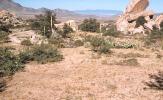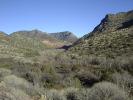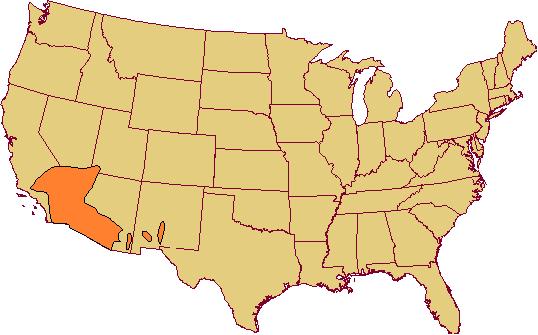


The southern desert shrub area is a true desert shrub climax, and is located in Southeastern California, Death Valley, the Mojave Desert, southern Nevada, extreme southwestern Utah (Virgin River area), western and southern Arizona, southern New Mexico (Rio Grande and Pecos Valley), and the Sonoran Desert area of Mexico.
Climate. The climate is characterized by extreme heat and aridity. Precipitation varies from 5 to 12 centimeters, but is less than 15 centimeters over most of the area. In the Mojave Desert, precipitation comes in winter. Eastern Arizona, New Mexico, and Texas receive summer rains which permit summer growth of perennial grasses. Temperatures are high in summer, often reaching 55 C, and occasionally 70 C. Winter temperatures seldom fall below 10 to 12 C.
Soils. Most soils in this region are aridisols with low organic matter and inherent fertility. Due to low precipitation, many give the appearance of entisols, which also exist in the region. Sheet erosion has left the surface with a thin layer of small rocks (an erosion pavement). A vesicular layer (porous crust) also develops on soil surfaces impeding infiltration.
Vegetation. The shrub life form that occurs in deserts is an adaptation from herbaceous forb ancestors. The herbaceous habit has been modified to shrubs and half-shrubs having an aerial body that does not die down each year even though leaves may die and fall off in extremely dry periods and be replaced from new buds. The dominants are bushy shrubs, 60 to 120 centimeters tall, that stand far apart (often averaging 9 meters apart) but their roots spread widely and occupy the soil fully. If tops are killed, root sprouts emerge. Principal dominants in the area include Creosotebush (Larrea divaricata), Spanishbayonet (Yucca), bursage (Franseria dumosa) ,Cenuryplant (Agave), Ocotillo (Fouqueiria), Acacia sp., Cacti (various genera),and Joshuatree (Yucca brevifolia). There are a number of plant associations in the southwestern desert shrub climax, the principal ones being the following:
Management. Utilization for grazing depends on stock water supply and forage. The Arizona desert is used largely by sheep during winter and spring and by scattered bands of desert cattle. Growth of forage is rapid after rain storms, hence is abundant in good season. Average carrying capacities are very low - 20 hectares per animal unit on some lands to 80 or more on the poorer ones. Drouth is a serious handicap to the livestock industry. Management necessitates reducing stock number during dry periods, storing feed for drouths, and carrying reserve feed "on the ground" in the form of ungrazed grass. The livestock enterprise is mainly one of breeding stock. Fat animals are not produced, but the area supplies feeders and stockers.